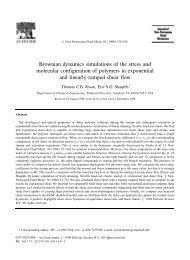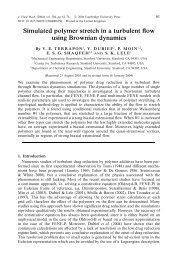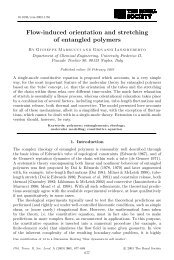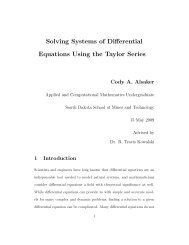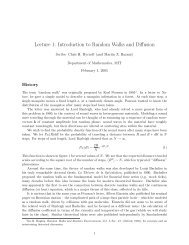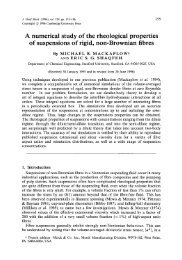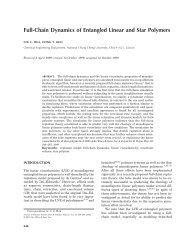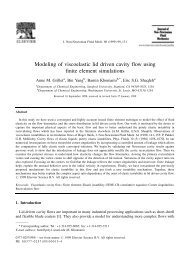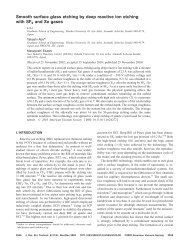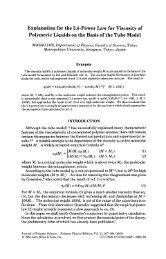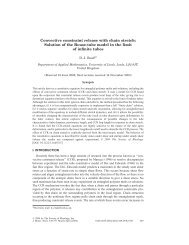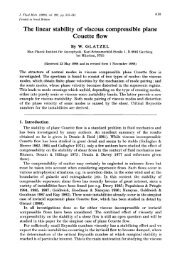Molecular modelling of entangled polymer fluids under flow The ...
Molecular modelling of entangled polymer fluids under flow The ...
Molecular modelling of entangled polymer fluids under flow The ...
You also want an ePaper? Increase the reach of your titles
YUMPU automatically turns print PDFs into web optimized ePapers that Google loves.
1.4. DEFORMATION KINEMATICS 5<br />
<strong>flow</strong> to be in the x direction, the velocity gradient to act in the y direction, and the z<br />
direction to be parallel to the vorticity. Experimental data typically measure a range<br />
<strong>of</strong> relevant components <strong>of</strong> the stress tensor. <strong>The</strong> easiest component to measure is the<br />
force which directly opposes the shear, namely the shear stress, σ xy . Polymer <strong>fluids</strong><br />
also typically exert a force normal to the shear plane. This stress is measured relative<br />
to atmospheric pressure and is expressed as differences between diagonal components <strong>of</strong><br />
the stress tensor. Two independent stress differences can be defined: the first normal<br />
stress difference, N 1 = σ xx − σ yy and second normal stress difference, N 2 = σ yy −<br />
σ zz . Considerable experimental effort is required to produce reliable normal stress<br />
measurements in shear [Meissner (1972)]. Since shear contains both extensional and<br />
rotational characteristics, the principle stretching direction rotates as the <strong>flow</strong> proceeds.<br />
As a result, despite being a comparatively simple experiment, it can pose theoretical<br />
difficulties.<br />
Extensional <strong>flow</strong>s are rotation free. <strong>The</strong>y may be achieved by increasing the length<br />
<strong>of</strong> a sample exponentially in time, producing a linearly increasing velocity pr<strong>of</strong>ile. This<br />
constant velocity gradient is the extension rate, ˙ɛ, and from this the Hencky extensional<br />
strain, ɛ can be defined as ɛ = ∫ ˙ɛ(t ′ )dt ′ . <strong>The</strong> actual extensional strain is exp( ∫ ˙ɛdt).<br />
Conventionally, extension is taken to occur in the x direction. To maintain a fixed volume<br />
the two remaining directions can be allowed to contract equally, which is known<br />
as uniaxial extension. Alternatively, one direction can be held fixed, forcing the final<br />
direction to contract sufficiently to maintain the volume, which is called planar extension.<br />
For both <strong>flow</strong>s the first normal stress difference can be measured and in planar<br />
extension there is also a second normal stress difference. <strong>The</strong>se extensional <strong>flow</strong>s, particularly<br />
planar extension, are difficult experiments and the necessary equipment is only<br />
available in a limited number <strong>of</strong> laboratories. Other extensional <strong>flow</strong>s are feasible, such<br />
as bi-axial <strong>flow</strong>s, however data for such deformations are rare. <strong>The</strong> velocity gradient<br />
and deformation gradient tensors for these simple <strong>flow</strong>s are shown in table 1.1.<br />
1.4.3 Flow in complex geometries<br />
<strong>The</strong> aim <strong>of</strong> many constitutive equations is to produce reliable quantitative predictions<br />
for as many <strong>of</strong> the above simple <strong>flow</strong>s as possible, using the same parameters for each<br />
<strong>flow</strong>. This is, <strong>of</strong> course, conditional on the availability <strong>of</strong> suitable data for comparison.<br />
However, almost all <strong>flow</strong>s which are <strong>of</strong> industrial relevance are complex <strong>flow</strong>s. Many<br />
complex <strong>flow</strong>s will be a combination <strong>of</strong> shear and extensional deformations and so a<br />
model which captures these simple <strong>flow</strong>s might be expected to perform well for <strong>flow</strong>s<br />
<strong>under</strong> a complex geometry if a suitable numerical implementation can be found. However,<br />
this conjecture is by no means a guarantee. For example, many complex <strong>flow</strong>s



